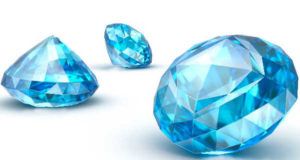IRRADIATED GEMSTONES

Some gemstones are exposed to radiation to enhance or change their color. Topaz is the most commonly treated stone. Typically orange, topaz becomes blue after it has been exposed. Diamonds and other precious gems may also be treated with radiation.
This process of irradiation can make the gems slightly radioactive. That is why the U.S. Nuclear Regulatory Commission regulates the initial distribution of these gemstones. The NRC requires the stones to be set aside, typically for a couple of months, to allow any radioactivity to decay. Under the NRC license, a distributer must conduct radiological surveys before the stones can be put on the market. These sophisticated surveys ensure no gems will be sold to the public unless the radioactivity is below levels that could pose health risks.
 Once the radioactivity has decayed and the stones have been distributed, they are exempt from NRC regulations. In other words, no license is needed to own or sell them. Subsequent distributors, jewelers, other retailers and consumers are exempt from NRC regulations.
Once the radioactivity has decayed and the stones have been distributed, they are exempt from NRC regulations. In other words, no license is needed to own or sell them. Subsequent distributors, jewelers, other retailers and consumers are exempt from NRC regulations.
The key is that NRC regulations apply to gemstones that contain radioactive material. Exposing the stones in a nuclear reactor or treating them in an accelerator can make them radioactive. But not all color-enhancing processes make gemstones radioactive.
If you have additional questions about irradiated gemstones, you may find answers in the Frequently Asked Questions section below. More information on the NRC’s rules for licensing consumer products for exempt distribution can be found on our website.
Frequently Asked Questions on Irradiated Gemstones
1. Is it dangerous to wear blue topaz? The NRC has no reason to believe that wearing irradiated gemstones can be harmful. There have been no reported cases of anyone being harmed by wearing them or any other irradiated gems.
2. How are gemstones irradiated?
This process can take place in a nuclear reactor (neutron bombardment), an accelerator (electron bombardment), or by exposure to gamma rays in an irradiator.
3. Does irradiation make the stones radioactive?
It can. In general, the longer the stones are exposed to radiation – and the more intense the radiation – the deeper and more attractive the color. This also increases the chance that trace elements in the stone will be “activated,” or become radioactive. Activation can occur in stones that are treated in a nuclear reactor or in an accelerator. Treatment using gamma radiation (high-energy photons), such as may occur in a cobalt irradiator, does not render stones radioactive.
4. A jeweler told me it is illegal to sell irradiated gemstones because they cause cancer – is this true?
There is no reason to believe any irradiated gemstones pose any health risk. The NRC has not advised, asked or ordered anyone to stop selling irradiated gems.
5. How can I tell if my jewelry has been irradiated?
A skilled gemologist might be able to tell by examining the gemstone. But it can be very hard to determine whether a stone has been treated in a reactor, accelerator or irradiator. Any residual radiation can be detected with a hand-held survey meter. Determining whether the radiation is below the NRC’s regulatory limits requires a trained radiation professional to use sophisticated survey equipment.
6. Will I receive a radiation dose from wearing irradiated gems?
Any dose from these gems would be extremely small. The NRC did a study to estimate the dose to a person wearing a large blue topaz stone (six carats). Assuming the stone had the highest level of radioactivity allowed under NRC regulations, the dose during the first year could be 0.03 millirem (NUREG 1717, page 2-21). But the radiation continues to decay, so the dose rate would go down over the course of the year. For comparison, having a porcelain crown or false teeth would give twice that dose (0.07 millirem), while a chest X-ray gives about 60 millirem.
7. Do I need an NRC license to sell irradiated gems?
Probably not. NRC regulations cover material made radioactive in a nuclear reactor or linear accelerator. The initial transfer of these materials must be done under an NRC distribution license. Once the radioactivity levels fall below certain limits, the materials become exempt from further regulation and no license is needed to buy or resell them.
8. Why does the NRC require a license for the initial distribution of irradiated gemstones?
The distribution license provides a safeguard against the possibility that stones might reach the market too soon after irradiation, with radioactivity above NRC limits. The licensee is required to perform sophisticated surveys to verify that the stones meet NRC requirements for exempt distribution.
9. Should I stop selling these popular gemstones?
That is a business decision. The NRC continues to allow licensed distributers to sell irradiated gemstones.
10. Why do some irradiated gemstones fall under NRC’s authority, while others do not?
All gemstones that are made radioactive fall under NRC regulations. Stones treated in a cobalt irradiator do not become radioactive and thus are not under NRC authority.